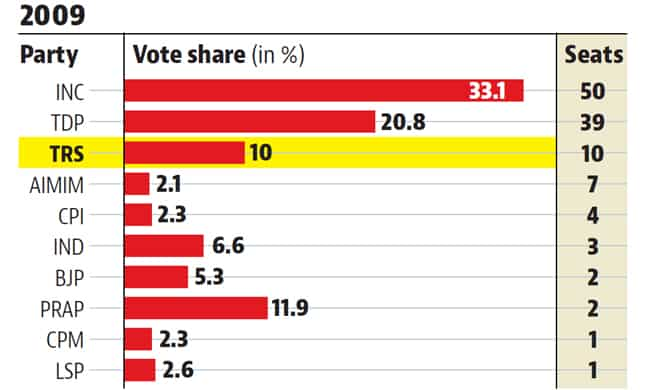Why a possible TRS-BJP alliance will have an edge in Telangana
The move was preceded by political posturing by the Telangana Rashtra Samiti in favour of the Bharatiya Janata Party.
With Telangana chief minister K Chandrashekar Rao, dissolving the assembly the state is headed towards early elections. The move was preceded by political posturing by the Telangana Rashtra Samiti (TRS) in favour of the Bharatiya Janata Party (BJP). Although it is not a part of the National Democratic Alliance (NDA), the TRS voted for the NDA candidate in the crucial election for the Rajya Sabha deputy chairman’s post. This has generated talk of a possible tie-up between the two parties.

Statistics from the 2014 assembly elections suggest that such a tie-up will have formidable political support and could even take on a united front comprising of the Congress, Telugu Desam Party (TDP) and the Communist Party of India (CPI) and the Communist Party of India Marxist (CPI-M).
This analysis is based on votes polled by each party in the 2014 Telangana assembly elections. To be sure, the 2014 polls were held for the undivided state of Andhra Pradesh and the Election Commission of India does not give any separate statistics for the Telangana assembly elections.
HT has used the list of assembly constituencies (ACs) in Telangana assembly from the website indiavotes.com and then used the database created by the Trivedi Centre for Political Data at Ashoka University to look at the vote-share and seat-share for Telangana in 2009 and 2014. As the 2008 delimitation is likely to have changed the ACs before the 2009 elections, we restrict the comparison to just 2009 and 2014. Chart 1 shows these trends.

As can be seen, the TRS achieved a simple majority in the assembly with a vote share of 34% in the 2014 assembly elections. The improvement in the TRS’s performance was largely at the cost of the Congress and the TDP. The total number of seats won by the three big parties, Congress, TDP ad TRS, in the state remained constant at 99 in both 2009 and 2014 elections, although the composition shifted in favour of the TRS in a big way between 2009 and 2014.
If the 2014 pattern were to replicate itself, and if the TRS and the BJP enter into a pre-poll alliance in the state, they would have an edge over a possible alliance between the Congress and the TDP. Even a grand alliance of the Congress-TDP-CPI-CPI (M) will have a less than one percentage point lead over the TRS-BJP alliance.
To be sure, it could be the case that all parties contest separately and the TRS gains disproportionately in terms of seats due of division of votes in a first-part-the-post system. Things could change drastically if the TRS is not able to replicate its 2014 performance though.
(Vijdan Mohammad Kawoosa contributed to this story)






